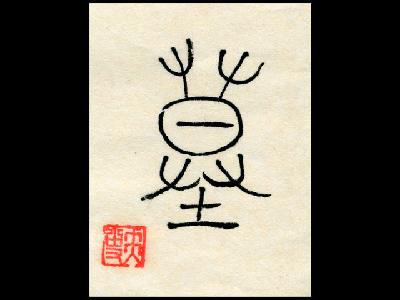【墓】 Bo, Haka Grave
|
In ancient China, corners of rooms were thought of as places where evil spirits can hide easily. Underground grave chambers of nobility are represented by the form 亜 (亞) indicating the four reeled off corners.
Ancient clan ‘insignia’ also had the standard form of 亞 with several inscriptions inside. As a rare example, among the inscriptions there also is an equivalent of the element 莫 (meaning ‘dark’). As in the later Tenbun (Zhuàn Wén) style, however, the form 亞 which means ‘grave’ did not remain, here also the lineage of the common explanation as ‘natural’ (not underground) grave as is usual also in traditional grave geomancy will be introduced in the following.
墓 is usually categorized as picto-phonetic character, here it is regarded as a pictograph in the first line. The character combines the upper part 艸 ‘grass’ and 日 ‘sun’ with the lower part, 艸 ‘grass’ and 土 ‘soil,’ showing a state of freshly green sprouting grass. With its sunshine, the bright shining sun fills the grassy plain with vivid life. This shows the ideal of the corpse returning to the soil and to nature. According to Yin-Yang thought, there has to be a balance of the sun (Yang) and the earth or soil (Yin).
Ancient clan ‘insignia’ also had the standard form of 亞 with several inscriptions inside. As a rare example, among the inscriptions there also is an equivalent of the element 莫 (meaning ‘dark’). As in the later Tenbun (Zhuàn Wén) style, however, the form 亞 which means ‘grave’ did not remain, here also the lineage of the common explanation as ‘natural’ (not underground) grave as is usual also in traditional grave geomancy will be introduced in the following.
墓 is usually categorized as picto-phonetic character, here it is regarded as a pictograph in the first line. The character combines the upper part 艸 ‘grass’ and 日 ‘sun’ with the lower part, 艸 ‘grass’ and 土 ‘soil,’ showing a state of freshly green sprouting grass. With its sunshine, the bright shining sun fills the grassy plain with vivid life. This shows the ideal of the corpse returning to the soil and to nature. According to Yin-Yang thought, there has to be a balance of the sun (Yang) and the earth or soil (Yin).
- name
- Editoral supervision: Dr. Christoph Schmitz, Researcher of Shirakawa Kanji Science, General and Japanese History of Philosophy and Thought
- hp
- http://nippon-kichi.jp/article_list.do?p=5332













